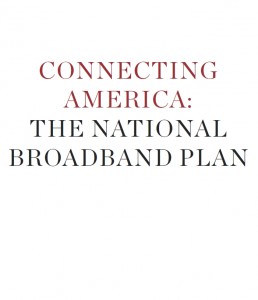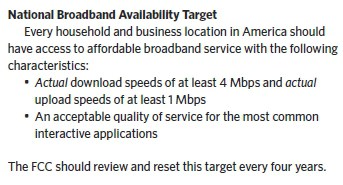 The long awaited National Broadband Plan (NBP) for the United States is here. Unveiled yesterday by the Federal Communications Commission, the 376-page plan calls itself a mandate for improved broadband service for 200 million Americans, bringing access to those who don’t have it, and better speeds and lower prices for those that do.
The long awaited National Broadband Plan (NBP) for the United States is here. Unveiled yesterday by the Federal Communications Commission, the 376-page plan calls itself a mandate for improved broadband service for 200 million Americans, bringing access to those who don’t have it, and better speeds and lower prices for those that do.
The report’s authors consider the broadband revolution a transformational change for the country, just as railroads opened the door to coast-to-coast transportation, electricity changed the American household, and phone service opened the door to a new era of Americans reaching out to communicate with one another.
Today, high-speed Internet is transforming the landscape of America more rapidly and more pervasively than earlier infrastructure networks. Like railroads and highways, broadband accelerates the velocity of commerce, reducing the costs of distance. Like electricity, it creates a platform for America’s creativity to lead in developing better ways to solve old problems. Like telephony and broadcasting, it expands our ability to communicate, inform and entertain.
Broadband is the great infrastructure challenge of the early 21st century.
To meet the challenge, the FCC was commissioned to develop a national blueprint for improving broadband service in the United States. A sense of urgency over statistics showing the United States ranking in the bottom half of nations — losing ground on speed, affordability, and access to both Europe and Asia meant the NBP must deliver concrete answers to improve the country’s competitive broadband standing.
This is a broad mandate. It calls for broadband networks that reach higher and farther, filling the troubling gaps we face in the deployment of broadband networks, in the adoption of broadband by people and businesses and in the use of broadband to further our national priorities.
Nearly 100 million Americans do not have broadband today. Fourteen million Americans do not have access to broadband infrastructure that can support today’s and tomorrow’s applications. More than 10 million school-age children do not have home access to this primary research tool used by most students for homework. Jobs increasingly require Internet skills; the share of Americans using high-speed Internet at work grew by 50% between 2003 and 2007, and the number of jobs in information and communications technology is growing 50% faster than in other sectors. Yet millions of Americans lack the skills necessary to use the Internet.
The NBP goes out of its way to recognize private enterprise’s influence on broadband development in the country, acknowledging America’s for-profit, largely unregulated broadband industry has successfully cherry-picked the most profitable customers for often excellent broadband service. For others deemed less profitable, a lesser amount of service, or no service at all is available. The distinction between America’s free market approach and government-run universal service is noted in the report. For America, the private approach has created a “digital divide” — the broadband have’s and have-not’s. The reasons for bypassing certain areas varies from the expenses to reach rural homes to affordability issues in the inner city. Sometimes, it’s a matter of being lucky enough to have a decent provider who is aggressive about deploying service.
The NBP seeks to build upon the private free market approach to broadband and fill in the gaps in service for those left behind.
The FCC’s plan envisions broadband evolution, not a broadband revolution. The report recommends maintaining a limited government role for broadband, and limited regulations along with it.
Instead of choosing a specific path for broadband in America, this plan describes actions government should take to encourage more private innovation and investment. The policies and actions recommended in this plan fall into three categories: fostering innovation and competition in networks, devices and applications; redirecting assets that government controls or influences in order to spur investment and inclusion; and optimizing the use of broadband to help achieve national priorities.

The NBP sets minimum actual broadband speeds Americans should expect to receive at 4/1Mbps. ADSL providers like Frontier, Windstream, and CenturyLink are already in trouble if this standard gets enforced. They routinely fail to meet these speeds in many areas today.
Among the core goals of the NBP:
- Connect 100 million households to affordable, 100Mbps service within 10 years, permitting high end video streaming and medical diagnostics;
- Define broadband as at least 4/1Mbps service, which automatically disqualifies a number of rural DSL providers and satellite fraudband;
- Pole attachment reform, which would remove obstacles providers encounter when trying to hang wiring on poles, bury it underground, or access rights-of-way;
- Improve rural broadband service and low-income access through Universal Service Fund reform, shifting up to $15.5 billion towards broadband construction and subsidies;
- Target a 90 percent broadband adoption rate among American households;
- Rely on mobile broadband to be an important competitor in the broadband industry by doubling available spectrum for wireless data and expand reach beyond today’s 60 percent coverage;
- Provide $16 billion in funding for a federal interoperable mobile broadband network exclusively for public safety agencies.
The plan is a marked departure from the FCC under former president George W. Bush. Just two years ago, the Commission suggested there were few problems with the broadband industry as-is. Michael Powell, who served under Bush’s first term as Chairman of the FCC, advocated free market deregulation, and dismissed concerns about the digital divide, calling it a “Mercedes divide,” suggesting broadband was like an expensive car he’d like to own but can’t afford.
Perhaps Powell can afford that car today, as honorary co-chair of industry front group Broadband for America, which has made its presence known through Powell on several national cable news channels in interviews about the broadband plan. The BfA’s role as an industry-backed player is not disclosed in interviews.
Opposition to parts of the NBP is likely to come from:
- Broadcasters, concerned about the further loss of the UHF TV dial for wireless broadband service expansion;
- Utility pole owners who will likely oppose changes in compensation formulas for pole attachment fees;
- Incumbent broadband providers who fear the NBP may lead to government-backed competition in their service areas;
- Consumers who may balk if Universal Service Fund reform adds an additional five or more dollars a month in fees to broadband bills without price reductions from real competition.
Some of the greatest concerns about the plan come from consumer groups, who recognize the plan has many good points, but relies too much on working with the same companies that got the United States into this position in the first place.
The Senate Commerce, Science and Transportation Committee has scheduled a hearing for Tuesday, March 23 at 2:30 p.m. to review the plan. The House Subcommittee on Communications, Technology and the Internet will hold its own hearing on the plan next Thursday, March 25.
[flv width=”640″ height=”500″]http://www.phillipdampier.com/video/Bloomberg National Broadband Plan Released – Controversies 3-16-10.flv[/flv]
Bloomberg Business News carried extensive coverage about the National Broadband Plan, its winners and losers, and other implications of a coordinated plan to improve service across America. (14 minutes)
[flv]http://www.phillipdampier.com/video/CNBC National Broadband Plan Implications 3-16-10.flv[/flv]
CNBC aired more skeptical coverage about the National Broadband Plan. Clueless Michelle Caruso-Cabrera is also back still insisting 99 percent of America already has access to broadband, but she speaks in terms of zip codes, not actual broadband coverage, and it’s unclear if she includes satellite “fraudband,” which promises broadband speeds but doesn’t deliver. Caruso-Cabrera also bashes Net Neutrality along the way. (13 minutes)
[flv width=”448″ height=”356″]http://www.phillipdampier.com/video/NBC News Channel FCC Seeks to Expand Access 3-16-10.flv[/flv]
From a less “business news” standpoint, the NBC News Channel explained the National Broadband Plan to ordinary consumers yesterday in terms of how the plan would affect them. (2 minutes)
[flv width=”640″ height=”500″]http://www.phillipdampier.com/video/WTTG Washington High-Speed Broadband Access for All 3-16-10.flv[/flv]
Local Washington, DC Fox affiliate WTTG-TV also explains the National Broadband Plan, suggesting it will bring “high speed access for all.” (3 minutes)


 Subscribe
Subscribe
“acknowledging America’s for-profit, largely unregulated broadband industry” Are they joking? Seriously, telecom and cable are two of the most heavily regulated businesses in the country – regulated, that is, in favor of the incumbents to the exclusion of competitors. Calling the current approach to broadband provision a free market approach is laughable, but I guess most Americans aren’t aware of even recent history and the almost-complete regulatory capture that cable and telecom companies currently enjoy.